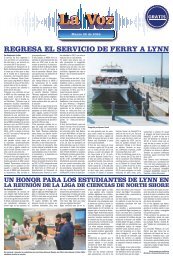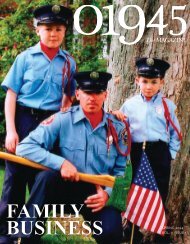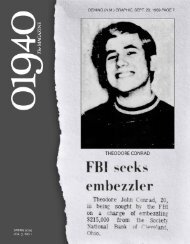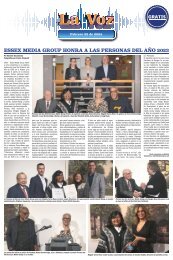01907 Winter 2020 V3
You also want an ePaper? Increase the reach of your titles
YUMPU automatically turns print PDFs into web optimized ePapers that Google loves.
WINTER 2020 | 31
GREEN BOOK, continued from page 16
Thompson and Eliza Dunston.
Anna’s father was from New York
and her mother from Maryland. At age
five, Anna was baptized at St. Mary’s
Catholic Church in Plainfield, so she and
Gaetano shared the same religion, and
attended St. John the Evangelist Roman
Catholic Church in Swampscott.
According to Anna’s obituary, she had
moved to Swampscott in 1935. During
the 1940s, Gaetano was not consistently
employed, and The Green Book lists their
house at 3 Boynton for consecutive years
as a tourist home. The 1940 census gives
one clue that the couple continued to rent
out rooms: in the column for “income
from other sources,” Gaetano is listed as a
“no,” but Anna is listed as a “yes.”
By the 1940s, the era of the summer
estates was coming to an end, and young
men from Swampscott enlisted in the
armed services and sought different
lines of work at the General Electric
and other manufacturing plants on the
North Shore. The leather industry where
Gaetano had worked was in decline.
Stories in the Lynn Telegram-News
detail devastating unemployment in the
industry following labor unrest during
the 1930s.
The 1940 census and Gaetano’s
1942 draft enlistment tell us he was
not employed and on welfare. Were
Gaetano’s employment problems related
to his mixed marriage? It’s not clear.
Long-time residents recall there were
few Black people living in Swampscott at
the time, and that the couple largely kept
to themselves. Anna could be seen sitting
on the shabby porch, they recollect, and
Gaetano would occasionally come out to
shush their dog when it would bark too
loudly at passersby.
Neighbors recall seeing limousines
in the 1940s and 1950s parked around
Boynton Street, and speculate that the
chauffeurs who drove well-heeled guests
from the nearby train station to the
elegant New Ocean House Hotel were
staying at Mrs. M’s house — with “M”
now standing for Mabel.
Anna “Mabel” lived in Swampscott
until her death at age 80 in 1967, a year
after the Green Book ceased publication,
though they had not listed the house in
The Green Book after 1954. According
to Anna’s obituary, her funeral was
held at St. John the Evangelist Church
in Swampscott, and she is buried in
St. Joseph’s Cemetery. Gaetano lived
at 3 Boynton for another seven years
The dining room with original built-in cabinets
at 3 Boynton St.
following Anna’s death.
One local resident who, as a teenager,
worked at Bickford’s Pharmacy on the
corner of Burrill and Paradise thinks he
remembers Gaetano walking to the store
from his run-down house on the corner
of Boynton and Pine to buy cigarettes.
Bickford’s kept a tab open for him, which
he would periodically pay off. Gaetano
died November 11, 1974 at the age of
78 at Lynn Hospital, and his funeral was
also held at St. John’s.
In their marriage, Anna and Gaetano
had attempted to bridge a racial divide.
In death, sadly, Anna and Gaetano were
not to be reunited. While Gaetano’s
obituary states his burial was planned
for St. Joseph’s, he is buried in the
Swampscott Cemetery in the World War
I veterans’ section.
A strike of Roman Catholic
gravediggers that began in early
November 1974 over a $1 per week
raise for the laborers brought Catholic
burials that November to a standstill,
threatening to devolve into a sanitation
issue for local funeral homes. It’s not
clear if this why Gaetano is interred
at Swampscott Cemetery, and not by
the side of his wife of 38 years. The
racially-segregated society that the
couple had so bravely defied in life was,
metaphorically at least, reflected in their
separate final resting places. Following
Gaetano’s death, the house, which was
part of Anna’s estate, was sold in 1975
to A. James Lynch, and then occupied
by numerous families for the next two
decades.
Three Boynton is now the home of
Jay and Kelly Duffy, who have owned the
house since 2016.
When asked to reflect upon the long
history of their home, Jay and Kelly
said, “We are thrilled that the story of
the Allen House has been unearthed. It
is important to resurrect the incredible
and seldom-told stories of Black lives in
Swampscott, which add so much to the
richness of the town’s history.”
The Duffys note that the history of
their home as a site of societal progress
endears the property to them.
“We strive,” they said, “to continue 3
Boynton’s tradition of welcoming friends into
our home based on their character alone.”
The Duffys expressed gratitude to the
Swampscott Historical Commission for
its on-going efforts to recover, preserve,
and write new chapters of Swampscott’s
complex history.
The author wishes to acknowledge the
kind assistance of Alyce Deveau, Marilena
Dipietro, Jay Duffy, Thor Jourgensen, Lisa
Mausolf, Alice McGuire, Justina Oliver,
Jackson Schultz, the Swampscott Historical
Commission, and the Swampscott
Historical Society.

















